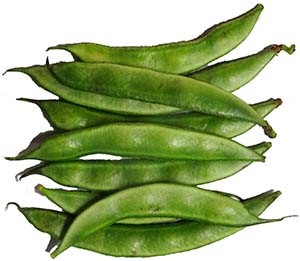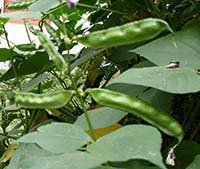Hyacinth bean (Lablab) Nutrition facts
The hyacinth bean, also known as the lablab bean, is a cultivar of pole beans within the Fabaceae family of legumes. Originating possibly in India, it is commonly cultivated in home gardens for its immature pods, which are consumed as vegetables. Additionally, the beans are appreciated in Japan as "fujimame," as well as in the Middle East, Central America, and Brazil.
Botanically, these beans are classified under the vine (twining) variety within the Fabaceae family, specifically the genus Lablab.
Scientific name: Lablab purpureus.
They are also referred to by various names such as dolichos bean, seim bean (सेम फली), Egyptian bean, bonavist bean/pea, dolico lablab, fagiolo indiano, among others.
 |
| Hyacinth (Lablab) beans. |
The lablab bean, a variety of annual Dolichos beans, shares close relations with black-eyed peas and yard-long beans. Hyacinth, a tropical perennial twining plant, requires a trellis to support its growth and can persist as a short-term perennial under favorable moisture and weather conditions.
Clusters of purple/white flowers give way to flat, thick, slightly curved green pods with pointed ends. Each pod typically contains two to six round or oval seeds, ranging in color from light green to cream, black, brown, or mottled, with a prominent white hilum covering approximately one-third of the seed.
Fresh, immature lablab beans are harvested, with the entire pod, including its skin, being edible much like green beans. The dried beans, however, can be used as a substitute for other legumes in various recipes.Health Benefits of Hyacinth (Lablab) Beans
Raw hyacinth pods contain only 46 calories per 100 grams, while dry mature seeds pack a higher caloric punch at 344 calories.
Dry hyacinth beans provide 23.90 grams or 44% of the recommended daily allowance of protein.
Dry lablab beans are notably rich in dietary fiber among pole beans, with 100 grams of dry beans providing 25.6 grams or 64% of the Daily Value (DV) of fiber. Dietary fiber acts as a bulk laxative, safeguarding the colon mucosa by reducing exposure to toxic substances and binding to cancer-causing chemicals in the colon.
Studies indicate that dietary fiber can lower blood cholesterol levels by decreasing the reabsorption of cholesterol-binding bile acids in the colon.
Hyacinth beans serve as gluten-free alternatives and are often recommended for individuals with gluten allergies or celiac disease.
Dry hyacinth beans are excellent sources of various B-complex vitamins such as thiamin, pyridoxine, riboflavin, pantothenic acid, folates, and niacin, which serve as co-factors for enzymes involved in carbohydrate, protein, and fat metabolism.
Dry hyacinth beans contain 1.130 milligrams of thiamin, covering 94% of the Daily Value (DV). Thiamin plays a crucial role in carbohydrate metabolism, and its deficiency can lead to Beriberi disease.
Fresh, immature hyacinth pods boast significant levels of vitamin A and K, with 100 grams providing 864 IU (29% of DV) of vitamin A. Vitamin A acts as a potent antioxidant, aiding in mucosal regeneration and maintenance.
Fresh pods are also rich in vitamin C, with 100 grams containing 12.6 milligrams (21% of DV). Vitamin C is a powerful water-soluble antioxidant, contributing to wound healing and tissue repair.
Dry lablab beans are a rich source of minerals, with 100 grams containing 148% of the DV for copper, 13% for calcium, 64% for iron, 71% for magnesium, 68% for manganese, 53% for phosphorus, and 84% for zinc.
Additionally, 100 grams of beans provide 1235 milligrams or 26% of the DV for potassium, an essential electrolyte crucial for maintaining cellular and fluid balance, countering the adverse effects of sodium on heart health and blood pressure.
| Principle | Nutrient Value | Percent of RDA |
|---|---|---|
| Energy | 344 Kcal | 17% |
| Carbohydrates | 60.74 g | 47% |
| Protein | 23.90 g | 43% |
| Total Fat | 1.69 g | 8.5% |
| Cholesterol | 0 mg | 0% |
| Dietary Fiber | 25.6 g | 67% |
| Vitamins | ||
| Folates | 23 μg | 6% |
| Niacin | 1.610 mg | 10% |
| Pyridoxine | 0.155 mg | 12% |
| Riboflavin | 0.136 mg | 10% |
| Thiamin | 1.130 mg | 94% |
| Vitamin A | 0 IU | 0% |
| Electrolytes | ||
| Sodium | 21 mg | 1.5% |
| Potassium | 1235 mg | 26% |
| Minerals | ||
| Calcium | 130 mg | 13% |
| Copper | 1.335 mg | 148% |
| Iron | 5.10 mg | 64% |
| Magnesium | 283 mg | 71% |
| Manganese | 1.573 mg | 68% |
| Phosphorus | 0.372 mg | 53% |
| Selenium | 8.2 μg | 15% |
| Zinc | 9.30 mg | 84% |
Selection and storage
 |
| Lablab purpureus. |
In numerous Asian households, tender, immature whole lablab beans are frequently employed in cooking. Fresh beans are readily accessible in local markets across tropical countries.
Select fresh, tender, immature beans for vegetable use. Avoid shriveled, broken, cut, and bruised beans, as they are less appetizing and prone to spoiling early. To store, place them in the refrigerator like French beans for prolonged freshness.
Preparation and Serving methods
To start, rinse the beans under cold water to remove any dirt from the surface. Trim the ends, discarding any strings that come off easily with the ends. Then, cut the beans into uniform sections to ensure they cook evenly.
When dealing with dry beans, treat them as you would any other variety. Soak them in cold water for 6-8 hours. This soaking process, followed by boiling, helps eliminate anti-nutritional compounds and reduces the likelihood of flatulence.
Consider these serving suggestions:
Utilize fresh beans in stir-fries, stews, baked dishes, or salads.
In India, hyacinth beans are known as seim beans (सेम फली). Tender beans are commonly used in a dish called sem-aloo ki sabzi, which includes potatoes, onions, and tomatoes.
Che dau van is a beloved Vietnamese bean dessert made with boiled hyacinth beans, sugar, and coconut milk.
The whole immature pods are popularly known as Chapparada avarekayi (ಚಪ್ಪರದ ಅವರೆಕಾಯಿ-trellising lablab pole beans) in Kannada language. These beans are used in a delicious curry preparation served over rice.
Safety Profile
It is important to thoroughly cook hyacinth beans before consumption. Raw beans contain cyanogenic glycosides, which can lead to the release of cyanide gas and cause toxicity.
Cooking effectively removes these toxic substances, rendering the beans safe for consumption. (Medical disclaimer).
You may also like to read≻≻-
Adzuki beans nutrition facts and health benefits.
Chickpeas nutrition facts and health benefits.
Lima beans nutrition facts and health benefits.
fava beans nutrition facts and health benefits.
≻≻-Back to Legumes from Hyacinth bean. Visit here for an impressive list of vegetables with complete illustrations of their nutrition facts and health benefits.
≻≻-Back to Home page.
Further Resources:
Hyacinth mature seeds-USDA National Nutrient Database.
Raw, immature pods-USDA National Nutrient Database.